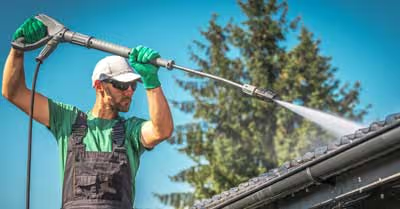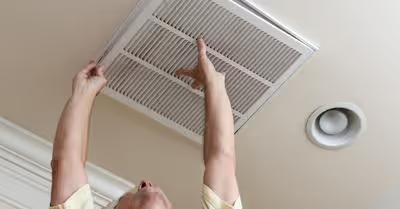Table of Contents
How To Fix A Toilet That Runs
This is the most common problem with older toilets. You may hear a hissing sound from the Toilet Tank, the upper part that is bolted to the Bowl. The sound may be constant, or intermittent. It happens when water leaks from the tank, down to the bowl, and out the waste pipe. The hissing sound is the water entering the tank through the fill valve. Fresh water must enter the tank to replace the water leaking out. The cause of the leak is usually the rubber flapper, which is a black or red rubber 'cork' that creates a seal between the water storage tank and the bowl
The water level inside the tank is regulated by a float, which may be a brass or plastic ball attached to an arm connected to the fill valve. As the float rises with the water level, it cuts off the flow of water from the valve to the tank at a predetermined level..
To fix this issue, first shut off the water supply to the toilet. On the right side of the toilet bowl, there is a supply line coming from a pipe in the wall. There will be a valve fixed on the pipe. Turn this valve clockwise to shut off the water supply. If the valve is old, it may be stuck. If it is, you can still shut off the water supply in the next step.
Lift the lid off the top of the toilet tank, and place it on a towel to avoid breakage. Flush the toilet and observe how the flapper lifts to allow the water to escape down to the bowl. If you were able to shut off the supply valve, you should be left with a nearly empty tank. If there is still water entering the tank through the fill valve, lift the float arm to shut off the fill valve. Temporarily prop up the arm with a painter's stir-stick. Be careful not to bend the arm, as that will adjust the water fill level.
Next, reach down and feel the rubber flapper. No need to be squeamish, the tank only holds fresh water. If the rubber feels hard, it is time for a new flapper. Over time, chlorine or other chemicals added to your city's water supply or hard water will cause the rubber to become brittle. Toilet bowl cleaning tablets dropped into the tank can also cause the flapper to harden.
Now, gently separate the rubber flapper from the arms holding it to the flush valve and lift it from the tank. There should be a chain connecting the flapper to the flush arm, remove this chain also. Take the flapper to your local hardware store and purchase a replacement. There are several different replacement types available, some resist hardening better than others, let your budget be your guide. Compare the spread of the mounting arms to be sure your new flapper valve will fit. Installation of the new flapper is the reverse of removal. Clean the area around the base of the tank where it contacts the flapper to insure a clean seal.
How To Fix A Toilet That Won't Flush
Another common problem is the water in the bowl not going down. Avoid the temptation to keep flushing, as this will only cause the bowl to overfill, creating more problems. There are several reasons this may be happening. Usually, the amount of waste being flushed is slightly more than the waste pipe can handle. Large balls of toilet paper or paper towels can temporarily clog the toilet.
The first thing to try is plunging the toilet. Plungers come in two different styles. One is made for plunging sinks and tubs and is flat bottomed. Toilet plungers have a funnel-shaped cone at the business end of the handle. This ensures a good seal between the plunger rubber and the bowl.
The working principle of plunging a toilet is to force a volume of air, trapped in the plunger funnel, downward through the base of the toilet on the 'down-stroke'. On the 'up-stroke', the vacuum created by pulling the plunger back into shape should pull the clog backwards within the pipe below the bowl base. Repeat this action slowly but firmly several times, then lift the plunger from the bowl.
This back-and-forth is usually enough to break up the clog, allowing the volume of water in the tank to push the material along through the waste pipe. Try this several times until the water flushes freely down the bowl. If this technique does not clear the clog, do not despair. There are other reasons why the toilet will not flush, but they are typically a bit more difficult to fix.
How To Fix A Toilet That Drains Slowly
When a volume of water drains down a sewer pipe, the same volume must be replaced. This is accomplished by venting the waste pipe. Several fixtures may be serviced by the same vent pipe along a waste pipe route. A slow draining sink that is not clogged may be a sign of an obstructed vent pipe. Vent pipes rise vertically from the waste line up through the roof and allow air to flow downwards to allow wastewater to drain.
Try dipping a straw into a glass of water. Hold your finger over the top of the straw and lift the straw out of the glass. The water trapped in the straw represents the water in your toilet that will not drain. Lift your finger, and the water drains out. The plumbing in your house acts the same way. Small animals, leaves or insect nests can clog this vent, as can hairballs and clots of grease.
Your hardware store probably sells a drain cleaning bladder, which attaches to your garden hose. Use a ladder to safely gain access to the vent pipe on the roof closest to the clogged toilet. Lower the bladder slowly down the vent pipe, until it runs into an obstruction. Have your helper turn on the water. The bladder will fill with water, sealing off the pipe. When the bladder reaches its maximum capacity, it will forcefully release a jet of water through a valve in its leading edge. This jet can break up the obstruction. Turn off the water and try to force the bladder further along the pipe. You may need to loosen the hose connection to release the pressure inside the hose. An old, stiff garden hose works best for this.
Diagnosing A Major Toilet Clog
If clearing the vent line does not work, you need to locate the sewer line clean out. It is a good idea to know where this is before you have a problem, as they can be difficult to find. Carefully open the cap covering the clean out and see if there is water running through it. A clog on the street end, or the downhill side of the cap, will immediately be evident by the sewage welling up from the clean out. If there is no water evident in the clean out, the clog is between the clean out and the house.
A toilet snake now must be used to clear the clog. Electric powered snakes are available from equipment rental companies for less than you can hire a plumber, but these powerful tools should be used only by experience operators. Watch a few instructional videos before you decide to try this yourself.
Other Common Toilet Issues
1.) How To Fix A Toilet Handle
Related to the problem of the toilet that keeps running, jiggling a loose handle can stop a toilet from running. This is not a flapper problem, but an issue with the flush lever. The handle is attached to a lever that lifts the flapper via an attached chain. Sometimes, the backing nut holding the handle to the tank front comes loose. This can cause a flushing malfunction.
Re-tighten the nut firmly, do not over tighten. Then observe the chain down to the flapper. Is it too tight? This will not allow the flapper to close completely. Loosen the chain by a few links at a time, until there is enough slack in it to allow the flapper to close and seal completely.
If the chain is too loose, the flapper will not lift completely, and will close before an adequate volume of flushing water makes its way down to the bowl. By trial and error, find the correct chain length.
Modern toilets have a push button on top of the tank lid instead of a flush handle. These new water-saving devices are relatively easy to adjust, and replacement parts are readily available.
2.) How To Fix A Toilet Water Level
If it seems that the bowl does not have enough water in it, lift the cover off the top of the tank. On the inside wall of the tank, there should be a fill line. The water level needs to be at the fill line. This is accomplished by slightly bending the float arm upwards. This will cause more water to enter through the fill valve before the float shuts it off. Keep bending the arm in small increments until the fill valve shuts off when the water reaches the fill line.
If the float arm is bent too much, water will continue to flow into the tank until it reaches the level of the overflow tube. The overflow tube leads down to the bowl, and excess water in the tank will be lost through this tube, causing the toilet to run, wasting water.
Newer toilets have a slightly different float system. Instead of an arm and ball, the float rises on a vertical slide. The level of the float is adjusted by turning a screw or adjustment knob in the direction indicated.
3.) How To Fix A Toilet That Leaks Water
The water tank is bolted to the toilet base with brass bolts and a series of rubber washers. Over time, the rubber can deteriorate, causing the tank to become loose, and water to leak. Tank bolts are available from your local hardware store and should be replaced at the same time as the flapper. Pay attention to the order the rubber and metal washers are installed.
Shut off the water supply and empty the tank. Using a flat blade screwdriver, prevent the bolts from turning while you unscrew the nuts under the tank. Remove the old bolts and rubber washers, clean the mounting surfaces, and re-install the bolts.
4.) How To Fix A Toilet Valve That Leaks
First, check the condition of the supply valve. Pinholes can develop over time in older pipes, and rubber seals in the valve can fail. Water to the entire house must be turned off to fix this issue. If the valve is screwed onto the supply pipe, simply remove it, and replace with a new valve.
If the valve is soldered in place, you can cut the old valve off. Leave as much pipe sticking out of the wall as possible. Clean the copper pipe and install a Shark Bite' valve, or a similar press-to-fit valve body.
5.) How To Fix A Toilet That Leaks When Flushing
Sometimes, water will leak out of the base of the toilet with each flush. The toilet needs to be loosened from the floor and fitted with a new wax ring. This is a thick, sticky doughnut made of a wax-like material that forms a seal between the toilet base and the toilet mounting flange. The ring helps direct water down the flange into the sewer pipe and keeps sewer gasses from rising into the home.
Shut off the supply valve and empty the tank. Unscrew the supply line from the bottom of the tank, then pry off the mounting bolt cover caps on either side of the toilet base. Unbolt the toilet and rock it slightly to loosen it from the floor.
Carefully lift the toilet off the mounting flange and set aside on a piece of cardboard. Clean the old wax off the mounting flange and install new mounting bolts. Tip the toilet on its side and clean off any old wax from around the hole in the bottom of the toilet. Press a new wax ring onto the toilet base, and carefully set the toilet down on the flange, aligning it with the two new mounting bolts.
Press down firmly and evenly until the toilet rests on the floor. Put a short level across the bowl, and level side-to-side, and front-to-back. Use plastic shims if necessary to level the bowl and tighten the mounting bolts. Cut off the excess bolt material and install new bolt cover caps.
Recent Articles
















